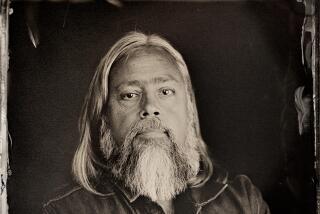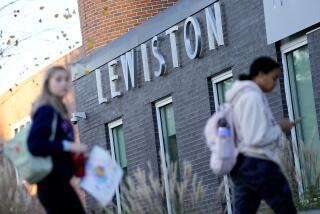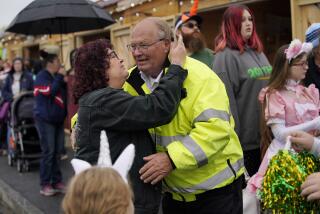‘Try to Blend In’ : French in Maine Bear Bias Quietly
LEWISTON, Me. — Among American minority groups, they may be the least visible, the most geographically isolated, the quietest in the face of discrimination.
They are the Franco-Americans of Maine, who make up one-third of the population--one of the largest minority groups in any state.
Yet Maine has never had a Franco-American governor or any other statewide elected official. It has never had a Franco-American Roman Catholic bishop, despite the fact that Franco-Americans are nearly 100% churchgoing Catholics.
‘Subtle Discrimination’
“Franco-Americans find it hard to get ahead in Maine,” said Robert Couturier, 44, a former mayor of Lewiston. “Subtle discrimination is still here,” he said, noting that hiring patterns in both state government and industry do not fully represent the proportion of Franco-Americans in the population.
Physically, Franco-Americans appear no different from the majority of Maine residents. But “we speak with an accent,” said Clare Bolduc, 38, a Franco-American who heads a legal aid group in Bangor. “We’re put down, considered backward because of it.”
Despite the discrimination, there is no Franco-American protest movement. No Franco-American murals adorn the walls in Lewiston, which is often called the French capital of Maine because 70% of the 40,000 residents are of French extraction.
Nor are there murals, Franco-American graffiti or French Power slogans scrawled on sidewalks, structures and fences in Augusta, Madawaska, Biddeford, Frenchville and other large Franco-American centers.
Avoiding Conflict
Instead, these descendants of some of the first settlers in North America have created their own institutions where they have been denied access to existing ones, and have quietly strengthened their own communities. In the process, they have avoided conflict and formed a flourishing enclave of French language and customs.
“We would rather fade into the wallpaper,” explained Couturier, now an attorney for the Insurance Society Assn. Canado-Americaine. “As a group, we don’t want to make too much noise. We are good citizens who go to church regularly and raise our families as best we can. We try to blend into the great American mosaic without making waves.”
For example, there were no Franco-Americans employed in Lewiston banks until after World War II. So Catholic members of the community turned their surplus money over to their church pastor for safekeeping.
That system gave birth to credit unions in Maine’s Franco-American Catholic churches, where parishioners banked money and made loans. The system continues to this day. The largest Catholic credit union in the state is at Saints Peter and Paul Church in Lewiston.
Lewiston Mayor Alfred A. Plourde, 48--sitting at a desk flanked by the Stars and Stripes and a blue flag with a white star and white fleur-de-lis, the official flag for Maine’s Franco-Americans--recalled that service clubs in Maine, such as the Rotary and Lions, refused membership to Franco-Americans until World War II.
“So, we have our own clubs like the Richelieu Club, a fraternity of French-speaking men. Our meetings are conducted entirely in French. It is a French version of the typical service club, raising funds for youth groups, etc.
“Every town with a large French population in Maine has numerous Franco-American clubs and cultural organizations.” He mentioned the Raquetteurs (Snowshoe) social clubs, and women’s clubs such as La Survivance Francaise, which is dedicated to the survival of the French culture.
But the institution that has best served Maine’s Franco-Americans has been the Catholic Church.
Andre Janelle, 34, legislative counsel governor and a Franco-American, said: “The French community never had a great amount of power on a statewide basis. Our primary goal has been a better life by staying together as a unit within the church.”
French Masses Crowded
Two of Lewiston’s landmarks are towering Maine granite Catholic churches, St. Mary’s and Saints Peter and Paul’s, where French-language Sunday Masses are always jammed to capacity.
Saints Peter and Paul’s, the biggest church in Maine, stands on a high hill overlooking Lewiston, as do Catholic churches in towns throughout France.
Dominican priest Father Herve Francois Drouin, 83, pastor emeritus of Saints Peter and Paul’s, recalled that “when I came here from Canada in 1940, the Franco-Americans were just coming out of the ghetto. Franco-American kids would finish eighth grade and be pushed into the mills to work. That was the extent of their education.”
Wages, traditionally low in Maine, “were about as low as you could get when I arrived,” he said. Then, one day, “textile union organizers saw this big church, walked in and asked for the priest. They said they were in Lewiston to organize the mill workers, nearly all of whom were Catholic and Franco-Americans.
“I asked them, ‘What took you so long in coming? You won’t have a fight from me.’ ”
When the mill workers began a bitter strike in 1941 over wages, Drouin supported it. “I was called a communist and a lot of other things. But it was necessary, just and long overdue,” he said.
In one form or another, the church has also educated most Franco-Americans. Most of the schools were first established by French Marist priests and Catholic nuns from France and Canada in the late 1800s. Many of the schools were built by the church, then presented to the community to be used as public schools. Until recent years, priests and nuns were the sole teachers and administrators of many public schools in Franco-American communities.
Nuns still teach regular classes in a few public schools in Maine. Religion classes are taught once a week at public schools in St. John Valley for an hour before regular classes begin, but the issue of the separation of church and state has not arisen in the close-knit Franco-American communities.
“Here, there has been a more tolerant attitude because of our isolation,” said Father Omer St. Onge, 64, pastor of St. Bruno’s Catholic Church in Van Buren.
Although English has become the predominant language in the schools, French continues to be spoken throughout much of Maine, as it has been for decades. The Maine Legislature is even a member of the Assn. Internationale des Parlementaires de Langue Francaise (International Assn. of French Speaking Parliaments), which includes legislators from France, Belgium, Haiti, French-speaking African countries and Canada.
The first French settlers arrived in 1755, when they were driven out of Nova Scotia by the British into the northernmost stretch of Maine along the St. John River, the boundary between Maine and New Brunswick. The exodus from the old French colony of Acadia drove settlers at the same time to Louisiana and Haiti.
In 1842, the Webster-Ashburton Treaty split the Acadians of the St. John River Valley under two flags, the Canadian and the American. Today, about 30,000 live in small towns on the Canadian side of the river, and 30,000 in small towns along the American side. The whole area on both sides of the river is known as La Republique du Madawaska (the land of porcupines) by locals.
From the 1880s through World War I, trainloads of French Canadians left Quebec for Lewiston, Augusta, Biddeford and other Maine cities and towns to work in the textile mills and shoe factories.
Despite that heritage, however, the identity of Franco-Americans in the state is almost a blur, even among the Franco-Americans themselves.
“Franco-American kids have an image problem. They don’t know who they are. The pressure (to learn) is here, but it is not the same as it is for Hispanics in California,” said Yvon Labbe, 46, director of Le Centre Franco Americain on the University of Maine campus at Orono.
“You check bookstores. You won’t find any Franco-American books. Franco-Americans played an important part in the history of this state. Yet nothing is taught about Franco-Americans in Maine schools.”
‘Lack of Trust in Ourselves’
The French in Maine, like Latinos in Southern California, have used different phrases to describe themselves over the years. It is only in the last few years that the term Franco-American has been used.
“We were known as French Canadians for years,” said Labbe. “Our ancestors may have been French and migrated here from Canada, but we’re not Canadians. We’re Franco-American.
“Here at the university, the janitors and secretaries are Franco-Americans. Very few of the faculty are. We needed a French professor to head our French Department. We sent to California for him. We have a lack of trust in ourselves.”
Labbe said he, like many Franco-American intellectuals in Maine, supports the idea of an independent Quebec “in our own self-interest. We must get over our paranoia about being French. There are 10 million French-speaking people in Quebec, the Canadian Maritime Provinces and New England. . . . “
But for most Franco-Americans, that notion is just one more issue that seems best left alone. “This is Maine, New England. It isn’t Southern California. It’s too cold to get excited. . . “ said Bolduc.
Added Father St. Onge: “Franco-Americans are comfortable enough being absorbed into another culture. If we were underdogs, discriminated against in a blatant manner, then the Franco-Americans would organize, rise up and complain. But as long as French are accepted, then our difference is clearly cultural.”
More to Read
Sign up for Essential California
The most important California stories and recommendations in your inbox every morning.
You may occasionally receive promotional content from the Los Angeles Times.










